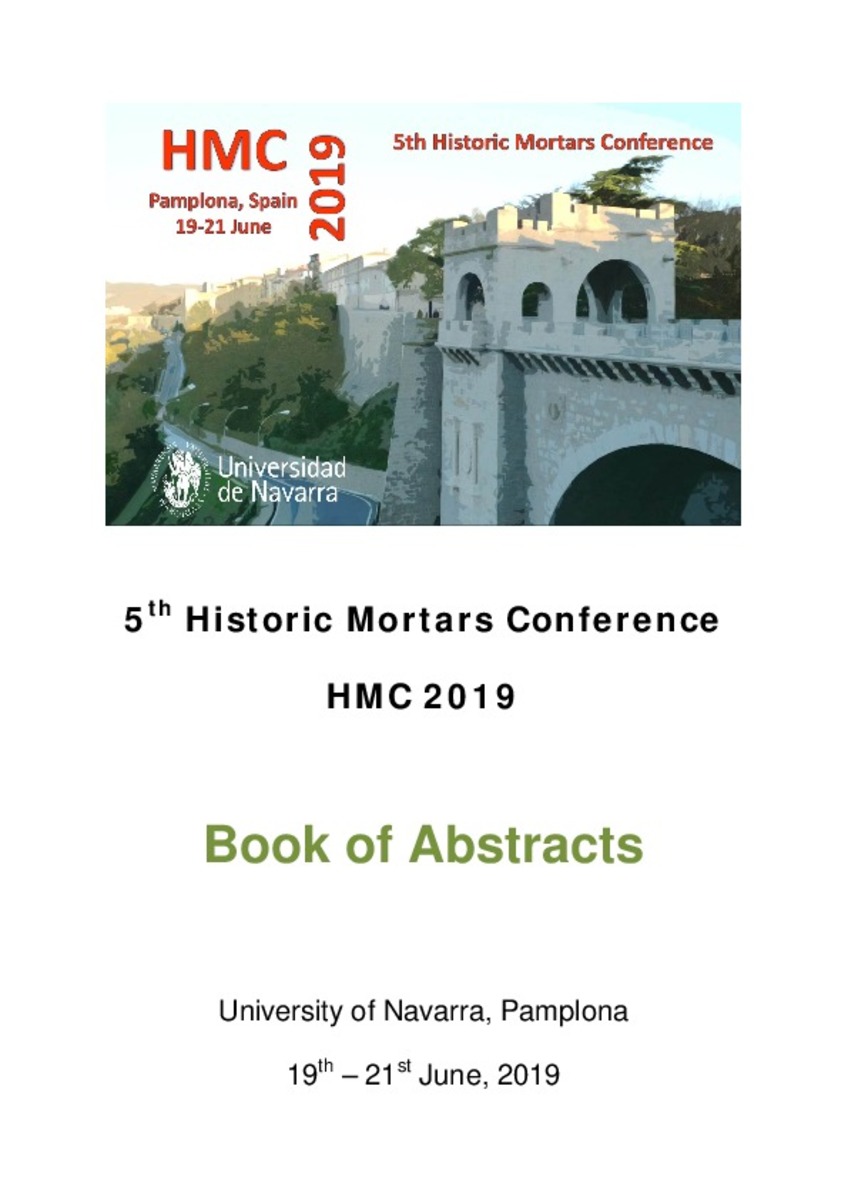Full metadata record
| DC Field | Value | Language |
|---|---|---|
| dc.creator | Gonzalez-Sanchez, J.F. (Jesús Fidel) | - |
| dc.creator | Tasci, B. (Burcu) | - |
| dc.creator | Martinez-de-Tejada, G. (Guillermo) | - |
| dc.creator | Fernandez-Alvarez, J.M. (José María) | - |
| dc.creator | Navarro-Blasco, I. (Iñigo) | - |
| dc.creator | Alvarez-Galindo, J.I. (José Ignacio) | - |
| dc.date.accessioned | 2019-02-25T11:23:11Z | - |
| dc.date.available | 2019-02-25T11:23:11Z | - |
| dc.date.issued | 2019-02-12 | - |
| dc.identifier.citation | González-Sánchez JF, Taşcı B, Martínez de Tejada G, Fernández JM, Navarro-Blasco I, Alvarez JI, Lime-based rendering mortars with photocatalytic and hydrophobic agents: assessment of the water repellency and biocide effect, en Alvarez, J.I. (José Ignacio); Fernandez, J.M. (José María); Navarro-Blasco, I. (Íñigo); et al. "Book of Abstracts of the 5th Historic Mortars Conference (HMC 2019)". Pamplona: Heritage, Materials and Environment (MIMED) Research Group, University of Navarra, 2019-02-12, p 50 | es_ES |
| dc.identifier.isbn | 978-84-09-09077-8 | - |
| dc.identifier.uri | https://hdl.handle.net/10171/56528 | - |
| dc.description.abstract | Different rendering mortars were prepared by mixing air lime and air lime-pozzolanic nanosilica with TiO2 and sodium oleate as photocatalytic and water repellent agents, respectively, added in bulk. The aim of the work was to design and obtain new rendering mortars with improved durability focusing in the reduction of the water absorption of these materials and in their biocide effect. To achieve a better distribution of the TiO2 particles, which was expected to enhance their efficiency, different dispersing agents were also incorporated to the fresh mixtures. Four diverse polycarboxylate ethers superplasticizers and a poly-naphthalene-sulfonate were tested. Workability and fluidity of the fresh rendering mortars were determined to guarantee the applicability of the final products. Water contact angle was monitored with the aim of assessing the hydrophobicity of the mortars. The biocide effect was studied by means of the culture of a strain of Pseudomonas fluorescens. The colonization of the mortars’ surface was analyzed by determining the number of colony forming units (CFU) after several days subjecting the samples to suitable T and RH conditions. At the same time, the surface of the mortars was irradiated with solar light to activate the photocatalyst. Results showed the efficiency of the sodium oleate in reducing the water uptake of the rendering mortars. Good compatibility between the water repellent agent, the pozzolanic additive and some of the polycarboxylate superplasticizers was observed. The presence of the photocatalyst was found to be very effective in preventing microbiological colonization. | es_ES |
| dc.description.sponsorship | Funded by MINECO under Project MAT2015-70728-P, and by the Government of Navarra under grant number Exp. 0011-1383-2018-000005, project PC065 RECURBAN. J.F. González-Sánchez thanks the Friends of the University of Navarra, Inc., for a pre-doctoral grant. | es_ES |
| dc.language.iso | eng | es_ES |
| dc.publisher | Heritage, Materials and Environment (MIMED) Research Group, University of Navarra | es_ES |
| dc.rights | info:eu-repo/semantics/openAccess | es_ES |
| dc.subject | Biocide | es_ES |
| dc.subject | Water Repellent | es_ES |
| dc.subject | Microbiological Colonization | es_ES |
| dc.subject | Photocatalytic | es_ES |
| dc.subject | TiO2 | es_ES |
| dc.title | Lime-based rendering mortars with photocatalytic and hydrophobic agents: assessment of the water repellency and biocide effect | es_ES |
| dc.type | info:eu-repo/semantics/conferenceObject | es_ES |
| dc.publisher.place | Pamplona | es_ES |
Files in This Item:
Statistics and impact
Items in Dadun are protected by copyright, with all rights reserved, unless otherwise indicated.






